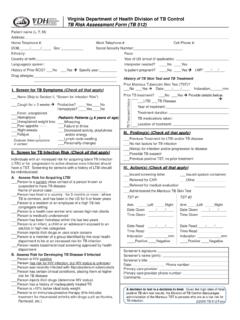Transcription of Fentanyl Safety Information for First Responders
1 Fentanyl Safety Information for First Responders Background An additional risk in the ongoing opioid epidemic is the potential exposure of First Responders to Fentanyl and other synthetic opioids. Fentanyl is a synthetic opioid that is 50-100 times more potent than morphine, which is increasingly seen on the drug market. Due to the cheap manufacturing cost, it is being mixed with other drugs and some users may not be aware that some substances contain Fentanyl , which is one factor in the growing number of overdoses in the past several years. The potential threat to First Responders is unknown, but First Responders should use caution when approaching unknown substances and overdose victims.
2 Risks to First Responders Because of Fentanyl s potency, health effects can occur at lower doses than with other drugs. For this reason, extra precautions should be taken to avoid exposure. If exposure occurs, look for symptoms such as respiratory distress, drowsiness, dizziness, disorientation, pinpoint pupils, nausea/vomiting, and loss of consciousness. Immediate response to any of these symptoms is important. The person should be moved to an area with fresh air and medical assistance should be requested. Naloxone can be administered as an antidote to opioid overdose, and due to the potency of Fentanyl , multiples doses may be necessary for breathing to return to normal.
3 By following good practices, such as the appropriate use of personal protective equipment (PPE), First Responders are not likely to be exposed to Fentanyl through ingestion, inhalation, mucous membranes (eyes, nose, etc.), skin contact, or with a needle stick. For moderate amounts of visible materials, PPE recommendations include: standard duty uniform, nitrile gloves, P100 filtering face piece respirator and Safety glasses. Further best practices and PPE recommendations can be found at the Interagency Board Skin exposure is NOT likely to lead to toxicity through absorption.
4 However, if your skin is exposed to Fentanyl , wash with soap and water as soon as possible and take measures to not touch your face, smoke, eat, or use the bathroom before washing. Alcohol-based hand sanitizers and bleach are not effective at removing opioids from skin, and may increase skin absorption. Working dogs are also at risk of exposure to Fentanyl and other synthetic opioids. Dogs should be removed from any area where Fentanyl may be present. In the case of exposure, contact the canine s veterinarian immediately. Naloxone may be administered under direction of a veterinarian to improve survival rate while the animal is being transported to receive veterinary What should First Responders do if Fentanyl may be present?
5 Assume that any white powder could be Fentanyl or its analogues Do not open packaged narcotics Do not field test unknown substances Wear nitrile gloves when handling narcotics Use soap and water to wash as soon as possible Call Poison Control Center 1-800-222-1222 if a healthcare worker or First responder has symptoms Keep Naloxone available for use in case of exposure CDC/NIOSH recommendationsiii Do not eat, drink, smoke, or use the bathroom while working in an area with known or suspected Fentanyl . Do not touch the eyes, mouth, and nose after touching any surface potentially contaminated with Fentanyl .
6 Field testing of Fentanyl or its analogues is not recommended due to an increased risk of exposure to Responders performing field testing. However, if detection and identification of Fentanyl is critical to the incident response, develop an incident plan to perform the field testing in accordance with agency policies and procedures. Personnel specifically trained to perform the field testing should perform the field testing in the appropriate PPE. Never handle Fentanyl and its analogues without the appropriate PPE. Avoid performing tasks or operations that may aerosolize Fentanyl due to increased exposure risks.
7 Activities that aerosolize Fentanyl require higher levels of PPE and should be conducted by appropriately trained personnel and in accordance with agency policies and procedures. Wash hands with soap and water immediately after potential exposure and after leaving a scene where Fentanyl is known or suspected to be present to avoid potential exposure and to avoid cross contamination. Do not use hand sanitizers or bleach solutions to clean contaminated skin. For more Information : Virginia Department of Health Division of Environmental Epidemiology 109 Governor Street; Richmond, Virginia 23219 Phone: (804) 864-8182 i Recommendations on Selection and Use of Personal Protective Equipment and Decontamination Products for First Responders Against Exposure Hazards of Synthetic Opioids, Including Fentanyl and Fentanyl Analogues.
8 The Interagency Board. August 2017. Accessed December 21, 2017. ii Training Video Helps Veterinarians Treat Opioid Overdoses in Dogs. American Veterinary Medical Foundation. June 28, 2017. Accessed December 21, 2017. iii Fentanyl : Preventing Occupational Exposure to Emergency Responders . The National Institute for Occupational Safety and Health (NIOSH). CDC. Accessed December 21, 2017.












